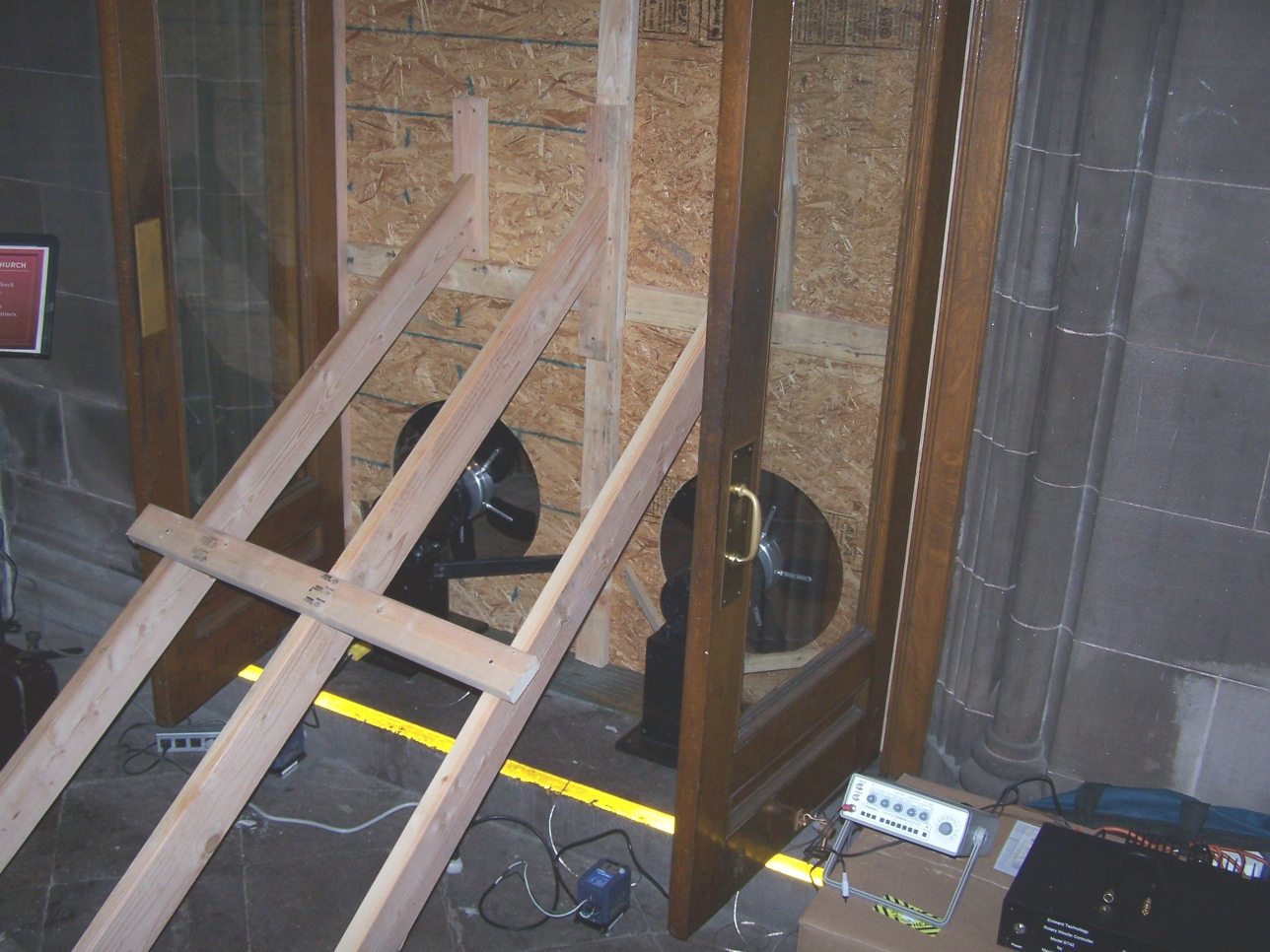
Making Cameron Carpenter's -Revolutionary- A Telarc recording using a Marshall and Ogletree virtual pipe organ with Eminent Technology TRW-17 Rotary Woofers. An outside view of the church bell tower which faces Wall Street. The historic Trinity Wall street Sanctuary was used for this recording

A view from the balcony at the rear of the sanctuary, one of two Marshall and Ogletree organ consoles is installed here. The stage is set for a Haydn Concert which took place March 10th and 11th, 2008 conducted by Jane Glover. The rotary woofers were installed during the daytime practice sessions.

A temporary recording studio was set up by Telarc. Speakers are being monitored by Robert Friedrich checking the mix real time. Switching back and forth both the two channel mix and the SACD mixed could be monitored. Bob Woods and Robert also liked to use headphones about 50% of the time.

Microphone cables were run from the recording studio into the sanctuary, here Bill McKinney, chief technician monitors mic levels. Once set, there was not much to do, unlike recording musicians, a pipe organ will not surprise you with greater sound levels than initially established with all the stops pulled.

Part of the crew, Front Left: Robert Friedrich, Front Right: Robert Woods, Right Rear: Richard Torrence, Middle Rear: Cameron Carpenter, Right Rear: Bruce Thigpen
The Walker subwoofer system already installed in the church for the M&O Organ consisted of 6 refrigerator sized enclosures using dual 15" woofers powered by 500 watt amplifiers for each enclosure for a total of 12 fifteen inch woofers and 3000 watts of amplifier power. Three of these woofer boxes were located in the front pipe chamber and three in the rear balcony. In the middle of the sanctuary, usable response measured down to 27Hz. On a 32' stop, about two thirds of the bottom notes C(0) to F(0) would be missing. Bob Woods, Telarc's President and Richard Torrence of Torrence and Yaeger who markets M&O organs asked Eminent Technology to participate in the recording.

The stage console was used for the recording. The Eminent Technology TRW-17 rotary woofer provided the foundation for the Marshall and Ogletree organ for the first time creating a virtual organ that enabled true acoustic reproduction of 32', 64', and even 128' foot stops at realistic sound levels. The instruments existing sampled 32' stops were divided by two to create 64' stops and sine wave stops were created and added to instruments ranks at 32', 64' and 128' to create a low frequency foundation for other stops. Cameron Carpenter interpreted and added these stops to the score in real time.

The Marshall and Ogletree organ adapted easily to its new low frequency capability. Doug Marshall and David Ogletree took existing 32' samples and also added "sine wave stops" with ranges matching 32, 64, and 128 foot pipes. This created a musical instrument for the recording that produced the lowest audible tones of any instrument in the world. (Today you can hear a M&O Organ with two rotary woofers permanently installed at Middle Collegiate Church in Manhattan)

Installing the rotary woofers: These doors formed the opening to a porch backspace volume used for the temporary rotary woofer installation. As you enter the main doors into the sanctuary the porch doors are located on the right.

Outside view of the porch which became the rotary woofers' "box" or backspace volume for this temporary installation.

Two TRW-17 rotary woofers (home versions) were used to fill the sanctuary volume estimated to be about 1 million cubic feet. Temporary OSB baffles were installed in the doorway between the side porch and the sanctuary.

The finished temporary installation from behind the baffles constructed by Winston Wright and Bruce Thigpen. The electric motors are 1/3 horsepower, 1725 rpm, each controlled by a frequency drive motor cotroller operating on 120vac. The blades were spinning approximately 800RPM. One 150 watt direct coupled audio amplifier was used driving both woofers in parallel. A balanced line level signal came from the M&O organ controllers sound card.

The sound pressure levels were set such that the lowest freqeuncy tones in these stops were approximately 10dB louder than the instrument's middle registers or about 105dB sound pressure level. Telarc placed the LFE microphone (Bruel and Kjaer 4007) about 30 feet from the temporary rotary woofer installation, where the measured response was +/- 3dB from from 6.5Hz to 24Hz. For the recording this is the only electronic pipe organ in the world with a 64' stop and the only organ of any type that could reproduce sounds from a 128' stop. During the recording the Marshall and Olgetree organ produced the lowest tones and had more octaves and range than any other pipe organ in the world.

The frequency response of the woofer system using pink noise. The sound pressure levels were set such that the lowest freqeuncy tones in these stops were approximately 10dB louder than the instruments middle registers. Telarc placed the LFE microphone (Bruel and Kjaer 4007) about 30 feet from the temporary rotary woofer installation, where the measured response was flat from 6.5Hz to about 25Hz.

The midrange and high frequencies from the organ are produced from two arrays of Definitive Technology speaker systems. This photo is of the array in the balcony. The arrays were powered by Carver Amplifiers. It was anticipated that this array was going to be used for the recording. Telarc spent approximately 14 hours testing microphone types and positions trying different microphone locations at the front, middle and rear of the sanctuary. A smaller array of speakers near the stage area ended up being chosen as the main left and right channels for the recording with surround mics closer to the rear speaker array.


